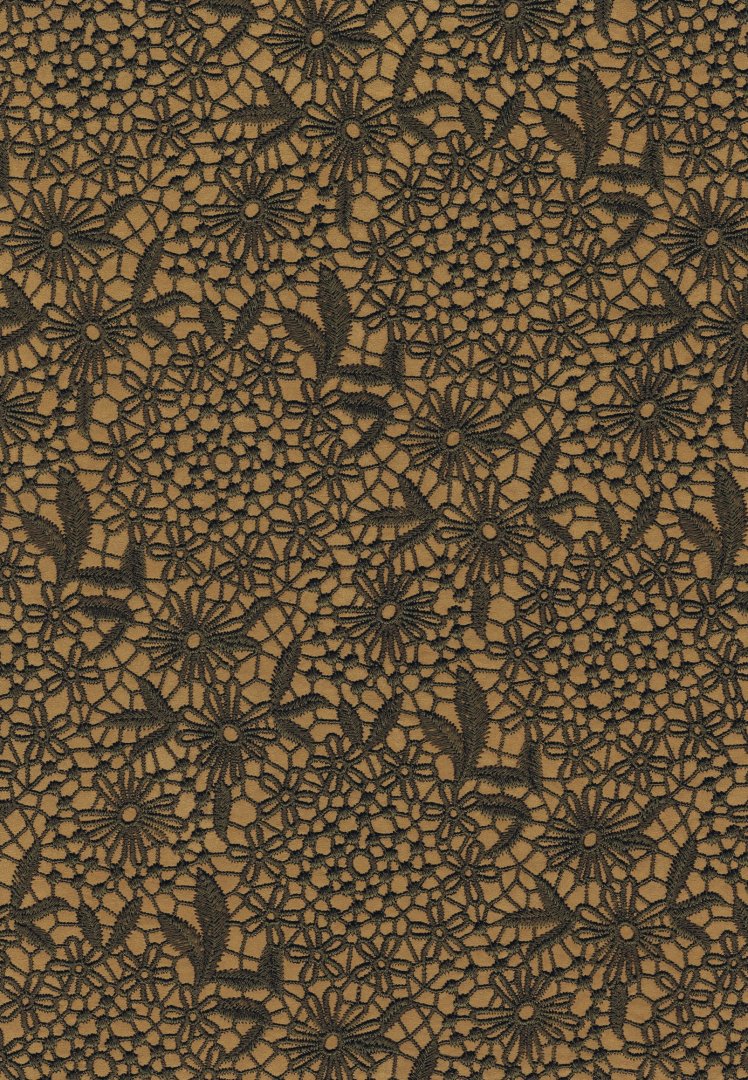Lace effect embroidery: art and technique for unique creations
Lace effect embroidery: origins and evolution
Lace effect embroidery represents a refined art form that draws on centuries of tradition and craftsmanship. This technique, with its roots deeply embedded in the history of textiles, continues to enchant and inspire through its elegance and complexity. Lace, originally made by hand using laborious techniques, has always been associated with nobility and luxury. Today, embroidery that imitates the effect of lace is adapted to modern production requirements, keeping alive the link with ancient craftsmanship.
The evolution of lace effect embroidery spans different eras and cultures, continually adapting to stylistic and technological changes. From the exclusivity of European royal courts to the accessibility offered by contemporary production techniques, lace embroidery has been able to renew itself. Its transformation has also been driven by innovation in embroidery materials and techniques, enabling a wide range of applications, from fashion to interior decoration.

Materials and tools for lace effect embroidery
Choosing the ideal base: tulle vs shoe mesh
The choice of base fabric is crucial in lace effect embroidery. Tulle, lightweight and transparent, is perfect for delicate creations such as wedding dresses and veils. For footwear, on the other hand, a stronger mesh is preferred, capable of supporting the embroidery while maintaining flexibility and comfort. This differentiation ensures that the embroidery is not only beautiful to look at but also functional for its intended use.
Yarns and needles: the allies of lace embroidery
The yarns used in lace effect embroidery are as varied as the techniques employed. Thin, strong yarns, such as cotton or polyester, make it possible to create fine, durable details. Needles, chosen according to the type of fabric and yarn, are equally important to ensure precision in the work. The combination of high-quality materials and the right tools is critical to achieving authentic-looking lace embroidery with remarkable durability.
Basic techniques of lace effect embroidery
Basic stitches: thrown and satin
Lace effect embroidery is characterized by its fineness and detail, aspects achieved through the use of various stitches. Among these, the thrown and satin stitches are fundamental.
Launched stitch, known for its versatility, makes it possible to create fine and delicate lines, ideal for outlining the contours of flowers and leaves.
Satin stitch, on the other hand, with its smooth, even surface, is perfect for filling in the inner areas of designs, giving them depth and volume.
The combination of these stitches in lace embroidery not only enhances the beauty of the design but also increases its perceived three-dimensionality and high-quality finish.
The French stitch: adding precious details to your embroidery
The French stitch adds texture and richness to lace effect embroidery work. This stitch, particularly prized for its ability to create small raised details, such as flower stamens or small fruits, is a valuable addition that enriches any piece.
Using French stitch requires precision and care, but the end result is extraordinarily beautiful, giving embroidery a unique dimension and luxurious look.
Motifs and designs in lace embroidery: floral inspiration
Interpreting nature: flowers and leaves
Floral inspiration is a recurring theme in lace effect embroidery, where nature is reinterpreted through the art of thread. Flowers and leaves, with their varied shapes and sinuous lines, become the stars of designs that reflect the diversity and beauty of the natural world. The ability to interpret these natural elements artistically allows for the creation of unique pieces, where every floral detail is enhanced by the precision of embroidery. These motifs not only celebrate the beauty of nature but also add a touch of elegance and freshness to fabrics.
Creating floral lattices: combining beauty and complexity
Floral lattices in lace effect embroidery represent one of the most complex and fascinating expressions of this art. These designs, which weave flowers, leaves and ornamental elements into geometric patterns, require careful planning and great execution skills.
The creation of floral lattices not only testifies to the high technical skill of embroiderers but also conveys a sense of harmony and aesthetic order. The ability to combine beauty and complexity in these compositions makes lace embroidery a true art form, capable of transforming a simple piece of fabric into a work of art.
Applications of lace effect embroidery: from fashion to accessories
Lace embroidery in high fashion: dresses and accessories
Lace effect embroidery plays a prominent role in high fashion, where it is used to add sophisticated details and a sense of luxury to dresses and accessories. This technique allows designers to express their creativity, creating unique garments that capture attention for their beauty and complexity.
Wedding dresses, gala gowns, and haute couture collections often feature lace embroidery as a distinctive element, demonstrating how this ancient art can be reinterpreted with a modern twist. The ability to customize designs and adapt them to each specific creation makes lace embroidery a favorite choice for those seeking timeless elegance.
Customizing footwear with embroidery: trends and techniques
Even in the world of footwear, lace-effect embroidery is becoming increasingly popular due to its ability to transform a simple shoe into a work of art. Using these embroidery techniques, designers can add intricate patterns and elegant details, making each pair of shoes unique. This customization not only responds to the latest fashion trends but also allows them to express their individuality.
Embroidery techniques used for footwear should ensure that the design is durable and suitable for everyday use, thus combining aesthetics and functionality.
Conclusion
Lace effect embroidery represents a connection between the past and the present, capable of combining traditional techniques with contemporary trends in fashion and design. This art, with its ability to transform ordinary materials into extraordinary creations, continues to be a source of inspiration for designers, artisans and textile enthusiasts worldwide.
Whether embellishing a couture gown or customizing an everyday accessory, lace embroidery offers endless creative possibilities. With the right combination of materials, techniques and inspiration, lace effect embroidery remains one of the finest and most versatile expressions of textile art.